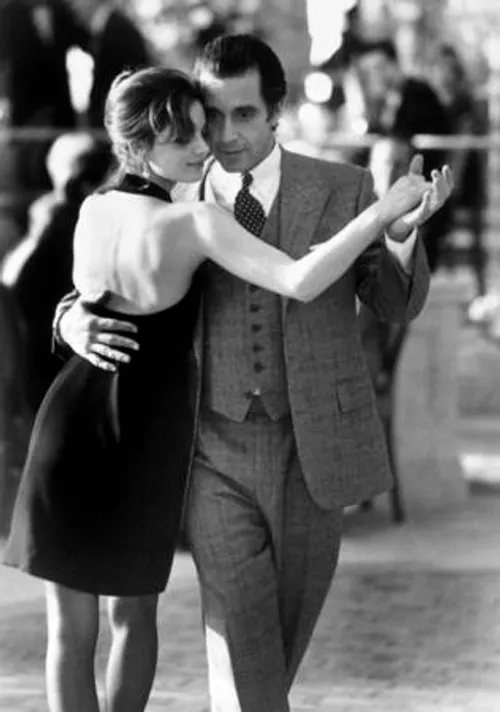Tango Trails & Spanish Tales
Discover Argentine culture & Spanish tips!
Why learn Spanish to dance tango better
(and vice versa)
If you’ve ever found yourself swept onto the dance floor of a milonga in Buenos Aires (or elsewhere!), you should have felt that there’s more to tango than just dazzling footwork and a passionate embrace. For many, the first images that come to mind when thinking of tango are pure Hollywood glamour—the flowing red dress, the rose clenched between teeth, and the iconic dance scene from Scent of a Woman set to the haunting melody of ‘Por una Cabeza’ (‘Just by a Head’). But after a few Spanish lessons and some actual time on the dance floor, you quickly learn those are just the shiny wrapping paper.
Inside this flashy surface, it’s the profound, often melancholic soul of Argentine culture woven into every step, and especially, every lyric. And believe me, understanding those lyrics in Spanish lays the secret ingredient to becoming a truly sensitive dancer, or a truly brilliant tango DJ.

The emotional depth of tango comes from its lyrics, the connection between partners, and the improvisational nature of the dance.
The Soulful Storyteller: Tango’s True Nature

Imagine the immigrants arriving in Argentina in the late 1800s – mostly young men, far from home, battling loneliness and poverty. Tango became their emotional outlet, their shared sorrow.
Carlos Gardel, the legendary voice of tango, sealed this with the first lyrical tango, ‘Mi Noche Triste’ (My Sad Night), written by Pascual Contursi in 1917. It wasn’t about hearts and flowers; it was about a man lamenting a lost love and his sad, empty room.
There is plenty of history of Tango in our Buenos Aires Experience course book, and we’ll dive in more in our upcoming blog posts.
Why Your Dance Needs More Spanish (for the Dancers)
Ever danced to a beautiful, smooth melody, feeling all romantic, only to find out the singer is lamenting a betrayal or an impossible situation? It happens!
Tango music can be deceivingly sweet, but the sentimiento (the deep feeling/emotion) of the song is carried by the words.
Learning Spanish vocabulary lets you connect directly with that emotion. You’ll stop just moving your feet and start feeling the story in your core.
Words to Learn in Context:
La mirada: The gaze. (Crucial for inviting someone to dance in a milonga via cabeceo – a nod from the head).
La tanda: A set of 3-4 tango songs, often by the same orchestra. (You dance one tanda with a partner).
El abrazo: The embrace. (The fundamental connection in tango).
El desamor: Heartbreak/lack of love. (A recurring theme in tango lyrics).
El bandoneón: The accordion-like instrument central to tango music.
Trivia: Did you know some tango songs have quite humorous or satirical lyrics, despite a seemingly serious melody? Without understanding Spanish and the context, you might miss the joke entirely!
Why Your Playlist Needs More Spanish (for the Aspiring DJs (Musicalizadores))
If you’re an aspiring tango DJ, or simply curate playlists for your home milonga, your responsibility is to create the perfect clima (atmosphere) and ambiente (vibe) for dancers. And that means understanding the songs you play.
I once heard a DJ play “Adiós, Muchachos” – a globally famous, catchy tango – during a tanda meant to build energy. While the tune is popular, the lyrics are profoundly sad: it’s a dying man saying goodbye to his friends, walking down memory lane.
For those who understand Spanish, it’s a poignant, reflective song, not one for sparking joy on the dance floor. A good musicalizador knows this!
Words to Learn in Context:
El musicalizador: The tango DJ.
La cortina: The short, non-tango song played between tandas to signal a break and the change of dancing partner.
La orquesta de tango: A tango orchestra. (Think of greats like Di Sarli, D’Arienzo, Pugliese).
El/La milonguero/a: A person who regularly dances tango at milongas.
La pista: The dance floor.
Curiosity: Many tango orchestras from the “Golden Age” (1935-1952) had distinct styles that are instantly recognizable to seasoned dancers. Learning about them (often discussed in Spanish!) helps you choose the perfect tanda. We’ll write about this, in our next posts.
Unlocking the True Tango Experience with TangoSpanish
Tango is inseparable from the history, the triumphs, and the heartbreaks of Argentina. From the immigrant experiences of the arrabal to the global phenomenon it is today, the story of tango is told in Spanish.
Learning Spanish with TangoSpanish isn’t just about vocabulary and grammar; it’s about unlocking the profound sentimiento of this unique dance and its music. It’s about truly understanding the cultural immersion that makes tango so much more than just steps. It’s about feeling the pulse of Buenos Aires in every word and every embrace.
#TangoSpanish #LearnSpanish #ArgentineCulture #TangoLyrics #SpanishVocabulary #Milonga #BuenosAires #Lunfardo #TangoDancer #TangoDJ
Are you ready to move from just dancing to truly feeling the tango?
Here’s why TangoSpanish one-on-one Spanish classes stand out:
🎯 Customized Lessons means tailored to your skill level, interests, and learning goals.
🔍 Cultural Insights means you will be learning Spanish through the lens of Argentine culture, tango history, and music.
🗓️ Flexible Scheduling classes are designed to fit your busy lifestyle.
🤓 Interactive Learning with engaging conversations and activities that make our Spanish learning process interesting, fun, and effective.
Ready to combine your love for music with language learning?
At TangoSpanish, we make learning Spanish an unforgettable experience. Whether you’re a beginner or looking to refine your skills, our one-on-one Spanish classes will help you achieve fluency while exploring the enchanting world of tango.
Book your first class today 50% off and discover how tango lyrics can transform your Spanish learning journey!
#ArgentineCulture #LearnSpanishArgentina #TangoSpanish #BuenosAiresCulture #WhatIsArgentineCulture #SpanishLanguage #CulturalImmersion #Asado #Mate #Lunfardo #RioplatenseSpanish